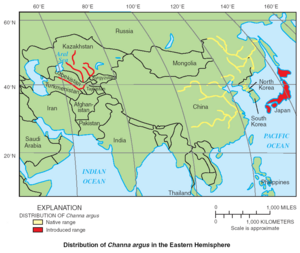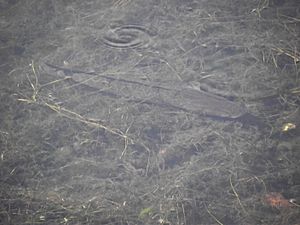Northern snakehead facts for kids
Quick facts for kids Northern snakehead |
|
|---|---|
 |
|
| Conservation status | |
| Scientific classification | |
 |
|
| Asian distribution of Channa argus (native in yellow, introduced in red). Source: USGS 2004 | |
| Synonyms | |
|
The northern snakehead (Channa argus) is a type of snakehead fish. It originally comes from countries like China, Russia, North Korea, and South Korea. This fish lives in rivers from the Amur River down to Hainan.
Sometimes, people have moved this fish to other places. In these new areas, it can become an invasive species. This means it can cause problems for the local fish and environment. For example, it was first seen in Czechoslovakia in 1956. In the United States, it is known as a very harmful invasive species.
Contents
What Does a Northern Snakehead Look Like?
Northern snakeheads have some special features. They have a long fin on their back called a dorsal fin. This fin has many soft rays, usually 49 to 50. They also have a fin on their belly called an anal fin, with 31 to 32 rays.
Their head is small and flat at the front. Their eyes are above the middle of their upper jaw. They have a large mouth that opens wide, going past their eyes. Inside their mouth, they have many small teeth in rows. They also have larger, pointed teeth on their lower jaw.
These fish usually grow to about 3.3 feet (100 cm) long. But some have been found to be much bigger, almost 5 feet (150 cm) long! The biggest one ever caught by a fishing group weighed about 17.7 pounds (8.05 kg). Another one caught in 2016 was even heavier, at 18.42 pounds.
Their color is usually golden tan to light brown. They have dark blotches, or spots, on their sides. They also have saddle-like blotches across their back. The spots near the front of the fish often split into top and bottom parts. The spots near the tail are usually connected.
Young snakeheads and adult snakeheads look very similar in color. This is unusual for snakehead fish. They look a bit like another fish called Channa maculata. But you can tell them apart by the two bar-like marks near their tail. In C. maculata, the back bar is usually solid. In C. argus, the back bar is uneven and blotchy.
How to Tell Them Apart from Similar Fish
Sometimes, people confuse northern snakeheads with Bowfins (Amia calva). This is because both fish have a long, cylinder shape. They also both have a long dorsal fin that runs along their backs. Bowfins are fish that eat other fish. They are common in the eastern United States and parts of Canada.
However, bowfins are native to North America. Northern snakeheads are not, and they are considered an invasive species. This means they can harm the environment.
Here are some ways to tell them apart:
- Northern snakeheads do not have a black eyespot near their tail. Bowfins usually do.
- Snakeheads are golden tan to brown with dark blotches.
- Snakeheads have a longer anal fin.
- Their head is more stretched out.
- Their upper jaw is shorter than their lower jaw.
- Northern snakeheads have scales that cover their whole body, including their head. Bowfins have smooth heads without scales.
Northern Snakehead Behavior
The northern snakehead lives in freshwater. It cannot live in very salty water. This fish has a special way to breathe. It can breathe both in water and in the air! This is because it has a special organ above its gills. This helps it take in air.
Because of this, it can live outside of water for several days. It can even wiggle its way to other ponds or streams. Young snakeheads can move short distances over land. Adult snakeheads usually do not move far on land.
These fish prefer quiet water with muddy bottoms and lots of plants. They also like slow, muddy streams. Northern snakeheads mainly eat other fish. But they also eat crustaceans (like crabs or shrimp), other small water animals, and amphibians (like frogs).
Northern Snakehead Reproduction
Northern snakeheads can grow their population very quickly. Their numbers can double in just 15 months. They are ready to have babies when they are two or three years old. At this age, they are about 12 to 14 inches (30 to 35 cm) long.
A female snakehead can lay 100,000 eggs in a year. The eggs are fertilized outside her body. This usually happens in shallow water early in the morning. The eggs are yellow and round, about 0.08 inches (2 mm) wide.
The eggs hatch after about one to two days. If the water is colder, it can take longer. The parents guard the eggs until the baby fish are strong enough to swim on their own. This happens when the babies are about 0.3 inches (8 mm) long.
Subspecies
There are two types, or subspecies, of northern snakehead:
- C. a. argus (Northern snakehead): Found in China and Korea.
- C. a. warpachowskii (Amur snakehead): Found in eastern Russia.
Northern Snakehead as an Invasive Species
In Asia, the snakehead fish is an important food fish. Because it is valuable, C. argus has been brought to many places in the United States. This happened either on purpose or by accident.
In the U.S., the snakehead is a top predator. This means it hunts and eats other animals. When it is introduced, it can be a big threat to the fish that naturally live there.
The fish first made news in the U.S. in 2002. A fisherman found one in a pond in Crofton, Maryland. People were worried it would harm the Chesapeake Bay area. Officials drained the pond to get rid of the fish. They found and destroyed two adult fish and over 100 young ones. A man later admitted he had bought two adult snakeheads from a market in New York. He then released them into the pond.
In 2004, 19 northern snakeheads were caught in the Potomac River. It was confirmed that they were breeding there. They mostly stayed in that part of the river. They were stopped from moving upstream by the Great Falls. The salty water of Chesapeake Bay stopped them from moving downstream. Tests showed these fish were not related to other snakeheads found nearby. This helped ease some worries about them moving over land. People continued to catch northern snakeheads in the river as of 2012.
Northern snakeheads have also been found in Florida. They might already be living and breeding there. Some have been found in New York City, Philadelphia, Massachusetts, California, and North Carolina. In 2008, northern snakeheads were found in ditches in Arkansas. This happened after a fish farm accident. Recent floods may have allowed them to spread into the White River. This could lead to them reaching the Arkansas and Mississippi Rivers.
In 2008, many northern snakeheads were found in Ridgebury Lake and Catlin Creek in Ridgebury, New York. The New York State Department of Environmental Conservation collected many native fish. Then, they used a chemical called rotenone to poison the waters. This killed all the fish to stop the snakeheads from spreading. After the poisoning, the fish were identified and measured. This was done before they were disposed of. The police were even on standby in case local people protested.
A new worry is that this fish is spreading close to the Great Lakes. If it gets into the Great Lakes, it could cause big problems for that ecosystem.
When the snakehead was found in Crofton, the chemical rotenone was used in three nearby ponds. This method killed all fish in the water. It helped prevent the spread of the very invasive snakehead. This chemical breaks down quickly, usually in one to three days.
In 2012, a snakehead was found in a pond in Burnaby, British Columbia. But it was a different type of snakehead, or a mix of types. Unlike the northern snakehead, this type usually lives only in warmer waters. Before its exact identity was known, British Columbia made laws to ban owning snakeheads and other potentially invasive species.
In April 2013, people saw northern snakeheads in Central Park's Harlem Meer in New York City. Officials asked fishermen to report and catch any they saw.
In late 2013, officials in Virginia and Maryland started counting snakeheads in the Chesapeake Bay. They wanted to understand how the fish were affecting the local environment. Virginia has made it a crime to bring snakeheads into the state without permission.
In October 2019, several snakeheads were found in a pond in Georgia. In August 2021, a 30-inch snakehead weighing 5 pounds was caught in a reservoir in Canton, Massachusetts.
World Record Catches
On May 24, 2018, Andrew Fox of Mechanicsville, Maryland shot a northern snakehead with a bow and arrow. This fish was officially the biggest ever shot in Maryland. It weighed 19.9 pounds and was 35.157 inches long. He shot it near Indian Head, Mattawoman Creek, in Charles County, Maryland.
On May 20, 2014, Luis Aragon of Triangle, Virginia, caught a northern snakehead weighing 17.7 pounds (8.05 kg). This was the biggest ever caught with a fishing rod and reel. This record was set by the International Game Fish Association. On May 20, 2016, Emory Baldwin of Indian Head, Maryland, caught an 18.42-pound northern snakehead. He used archery tackle in the tidal marshes of the Potomac. This fish is listed as the state record in Maryland.
Northern Snakehead in Traditional Culture
Some Chinese fishermen respect northern snakeheads. They see them as having good qualities. Parent snakefish are known to sacrifice themselves to protect their young. It is said that when the mother fish gives birth, she cannot hunt for food. Her young then rush to feed on her.
See also
 In Spanish: Cabeza de serpiente del norte para niños
In Spanish: Cabeza de serpiente del norte para niños




